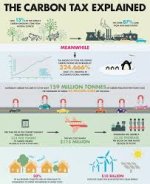As the climate crisis intensifies, governments and economists are searching for ways to reduce carbon emissions without paralyzing economic growth. Carbon taxes have emerged as a controversial yet powerful tool—but are they truly effective?
At its core, a carbon tax is simple: emit more carbon, pay more money. This pricing mechanism aims to internalize the environmental cost of pollution, pushing companies and consumers toward greener alternatives. In theory, it’s brilliant—make pollution expensive, and watch behavior change. In practice, the results are mixed, but promising.
Take British Columbia, for example. Since implementing a carbon tax in 2008, the province has reduced per capita emissions while still enjoying strong economic growth. Sweden, another leader in carbon pricing, has slashed emissions by over 25% since the early 1990s while maintaining a healthy economy. These success stories suggest that, yes, carbon taxes can work—when designed correctly.
But critics are loud and persistent. They argue that carbon taxes hurt low-income households, increase fuel prices, and can drive businesses overseas. These concerns are not without merit. A poorly designed carbon tax can widen inequality and lead to public backlash—as seen in France during the Yellow Vest protests. That’s why economists emphasize revenue-neutral carbon taxes, where the collected funds are returned to citizens as rebates or invested in green infrastructure.
Effectiveness also hinges on global cooperation. Carbon taxes in one country may be undercut if neighboring nations offer “pollution havens.” This makes international agreements and border carbon adjustments critical to leveling the playing field.
So, are carbon taxes effective? The evidence says yes—but only when they are fair, transparent, and part of a larger climate policy package. Carbon pricing is not a silver bullet, but it is a sharp arrow in the quiver of climate action.
The future of carbon taxation lies in political will and public trust. Get the design right, and carbon taxes could become the economic driver of a cleaner, more sustainable planet.
At its core, a carbon tax is simple: emit more carbon, pay more money. This pricing mechanism aims to internalize the environmental cost of pollution, pushing companies and consumers toward greener alternatives. In theory, it’s brilliant—make pollution expensive, and watch behavior change. In practice, the results are mixed, but promising.
Take British Columbia, for example. Since implementing a carbon tax in 2008, the province has reduced per capita emissions while still enjoying strong economic growth. Sweden, another leader in carbon pricing, has slashed emissions by over 25% since the early 1990s while maintaining a healthy economy. These success stories suggest that, yes, carbon taxes can work—when designed correctly.
But critics are loud and persistent. They argue that carbon taxes hurt low-income households, increase fuel prices, and can drive businesses overseas. These concerns are not without merit. A poorly designed carbon tax can widen inequality and lead to public backlash—as seen in France during the Yellow Vest protests. That’s why economists emphasize revenue-neutral carbon taxes, where the collected funds are returned to citizens as rebates or invested in green infrastructure.
Effectiveness also hinges on global cooperation. Carbon taxes in one country may be undercut if neighboring nations offer “pollution havens.” This makes international agreements and border carbon adjustments critical to leveling the playing field.
So, are carbon taxes effective? The evidence says yes—but only when they are fair, transparent, and part of a larger climate policy package. Carbon pricing is not a silver bullet, but it is a sharp arrow in the quiver of climate action.
The future of carbon taxation lies in political will and public trust. Get the design right, and carbon taxes could become the economic driver of a cleaner, more sustainable planet.

